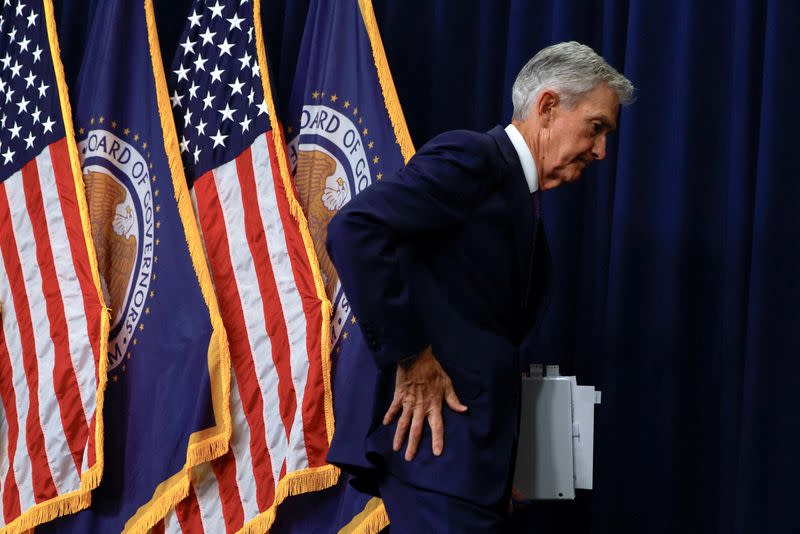In new forecasts, Fed appears to bow out of the election cycle

(Reuters) -The U.S. Federal Reserve may have just ducked out of the presidential campaign spotlight with a fresh set of forecasts showing no interest rate cuts are likely until after Election Day.
Central bank policymakers on Wednesday kept their benchmark interest rate unchanged at 5.25%-to-5.50%, where it has been since last July.
They also issued projections showing greater hesitance than before about starting reductions in high borrowing costs that have made it more costly for Americans to buy anything on credit from a washing machine to a car to a house - a dynamic that has contributed to consumers' persistently poor view of the economy and Democratic President Joe Biden's management of it.
As recently as March, Fed officials were forecasting interest rates would fall by three-quarters of a percentage point this year, an outlook that would have meant cuts beginning this summer and continuing through the run-up to the Nov. 5 presidential election. That could have opened the Fed to criticism that it was tilting the scales late in the rematch between Biden and Republican former President Donald Trump.
Now, though, amid stickier-than-expected inflation and a still-strong job market, officials have scrapped that forecast for one that foresees just a single quarter-point cut this year, an outlook that suggests no action is likely before their final meeting of the year in December.
JAWBONING
Investors for their part have not fully abandoned hope for an earlier start, which would keep the Fed in the election limelight. Interest rate futures markets still assign a roughly six-in-10 chance of a rate cut in September.
A rate reduction then might improve consumer moods to the benefit of Biden, a prospect Trump had already begun taking aim at earlier this year.
“I think (Fed Chair Jerome Powell is) going to do something to probably help the Democrats, I think, if he lowers interest rates,” Trump said earlier this year in a Fox Business interview. “It looks to me like he’s trying to lower interest rates for the sake of maybe getting people elected, I don’t know.”
A delay until after the election could now be a headwind for Biden, who polls show receives low marks for his handling of the economy despite near-record low unemployment, record-high household wealth and above-trend growth.
"This is obviously bad news for Joe Biden’s campaign, who've been desperately trying to convince voters that the economy is in good shape thanks to so-called Bidenomics," Republican consultant Jeanette Hoffman said.
Asked about the shift, White House press secretary Karine Jean-Pierre said the administration had no comment "We've always been really clear about the Fed. They're independent. We do not comment on...the Fed."
“After four years of crippling inflation that’s hurting families everywhere from the grocery store to the gas pump, Americans trust President Trump to fix our economy and put more money back in their pockets, as he did in his first term," Trump Campaign National Press Secretary Karoline Leavitt said.
ELECTIONS AND THE FED
Election year rate cuts are not unheard of but are relatively unusual.
The most recent occurred in 2020, when, with Trump as president the Powell Fed cut rates to near zero in response to the sudden onset of the COVID-19 pandemic. Trump still lost the election to Biden that November.
The next most recent occurrence was when the Fed under Ben Bernanke cut rates repeatedly in the fall of 2008 as the financial crisis was erupting and Democrat Barack Obama and Republican John McCain were battling for the White House. Obama won.
In 1992, Alan Greenspan's Fed cut rates several times in the months before Election Day in the face of rising joblessness. Republican George H. W. Bush bemoaned what he saw as a too-little-too-late response from the Fed and blamed it in part for his loss to Democrat Bill Clinton.
"I think that if the interest rates had been lowered more dramatically that I would have been re-elected president because the [economic] recovery that we were in would have been more visible," Bush said in a 1998 interview with David Frost. "I reappointed him, and he disappointed me."
HOW A CUT COULD STILL HAPPEN
To be sure, circumstances in the next couple of months could change sufficiently to warrant a cut by the Fed at its meeting in mid-September, seven weeks before the election, though not necessarily in a way that might benefit Biden.
Powell at his press conference on Wednesday laid out two "tests" for starting rate cuts: The Fed either gets more confidence that inflation is moving sustainably toward the central bank's 2% goal, or there is an "unexpected deterioration" in labor market conditions.
If the first test is the trigger, that could bode well for Biden. If it is the second, it could be to Trump's benefit.
"If we saw troubling weakening more than expected" in the labor market, Powell said, that could move rate cuts earlier than now forecast. "We completely understand the risks, and that's not our plan..to wait for things to break and then try to fix them."
(Reporting By Dan Burns; Additional reporting by Ann Saphir and Nathan Layne; Editing by Andrea Ricci and Chizu Nomiyama)

 Yahoo Finance
Yahoo Finance 